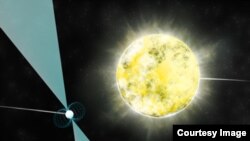Astronomers say they’ve discovered “an Earth-size diamond in space.”
The white dwarf star, some 900 million light-years away, could be the coldest and faintest such star detected.
“It’s a really remarkable object,” said David Kaplan, a professor at the University of Wisconsin-Milwaukee who led a team of researchers, in a statement.
Kaplan and his team discovered this stellar gem using the National Radio Astronomy Observatory’s Green Bank Telescope and Very Long Baseline Array, as well as other observatories.
White dwarf stars form when stars collapse into a super dense Earth-size object. They are thought to be made of carbon and oxygen. This particular white dwarf is thought to be 11 billion years old, or roughly the same age the Milky Way galaxy.
Because of its age, it has likely cooled to the point where the carbon has crystallized into a substance “not unlike a diamond.”
The star was discovered because of its partner star, a pulsar called PSR J2222-0137.
Pulsars are remnants of collapsed stars which emit beams of electromagnetic radiation.
According to the researchers the pulsar was spinning “more than 30 times each second and was gravitationally bound to a companion star.” The two stars circled each other every 2.45 days.
That companion star was thought to be a neutron star or a white dwarf.
By observing how the companion “warped” space and delayed the precise radio signals of the pulsar, the researchers were able to “identify the orientation of their orbit and the individual masses of the two stars.
With such precise information, researchers expected to be able observe the white dwarf in both optical and infrared light. But the star could not be detected by either the Southern Astrophysical Research telescope in Chile nor the 10-meter Keck telescope in Hawaii.
“Our final image should show us a companion 100 times fainter than any other white dwarf orbiting a neutron star and about 10 times fainter than any known white dwarf, but we don’t see a thing,” said Bart Dunlap, a graduate student at the University of North Carolina at Chapel Hill and one of the team members. “If there’s a white dwarf there, and there almost certainly is, it must be extremely cold.”
The temperature of the white dwarf, researchers say, would be about 2,700 degrees Celsius. For comparison, our sun is about 5,000 times hotter at its center.
A paper describing these results is published in the Astrophysical Journal.
Astronomers Discover 'Earth-size Diamond in Space'
- By VOA News








